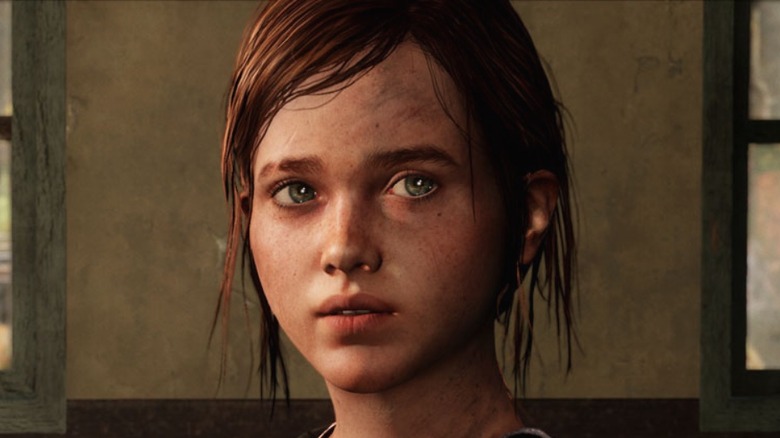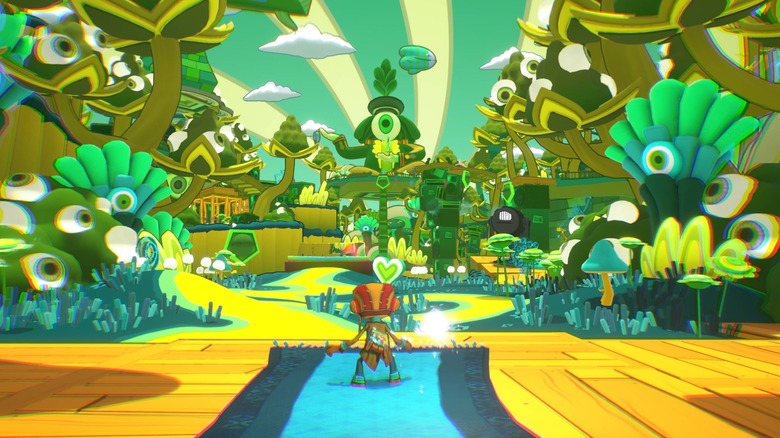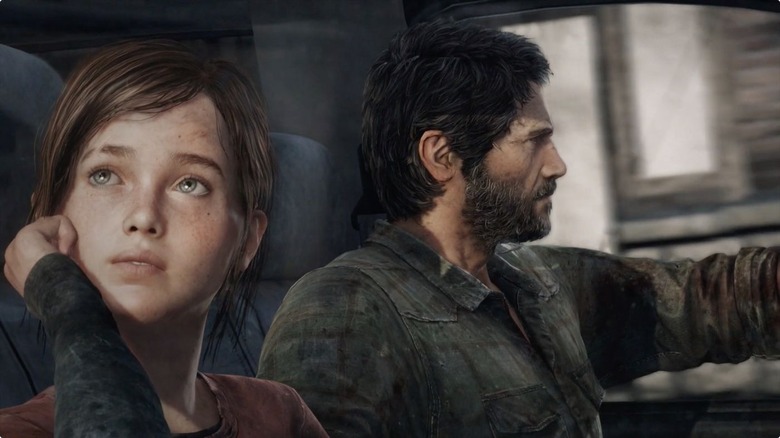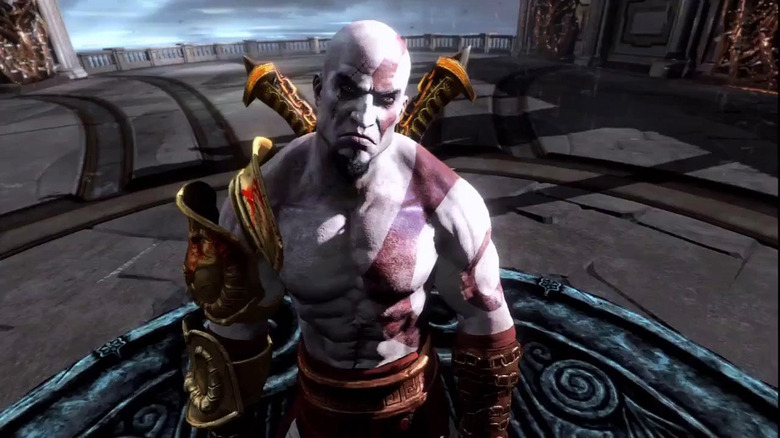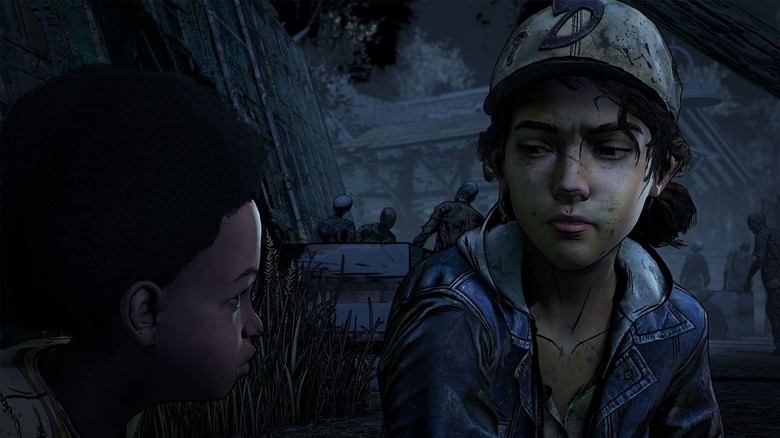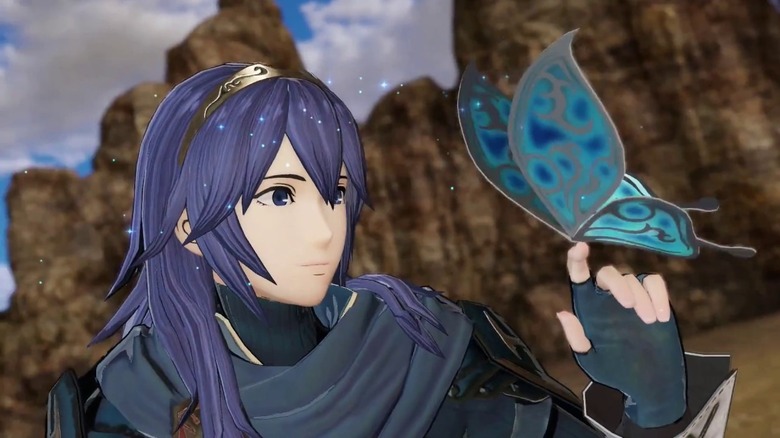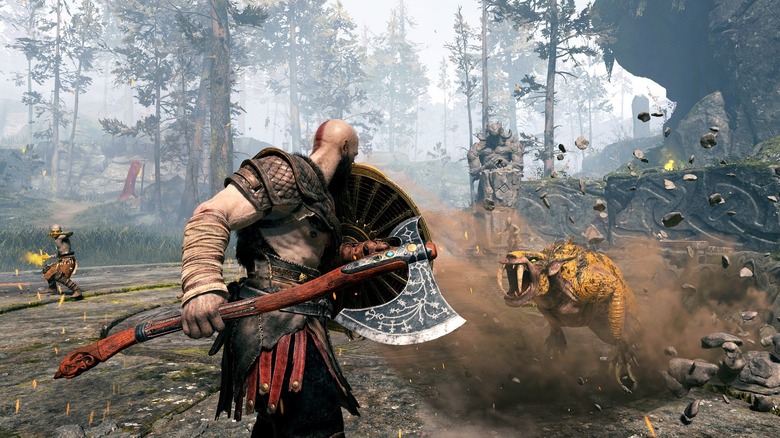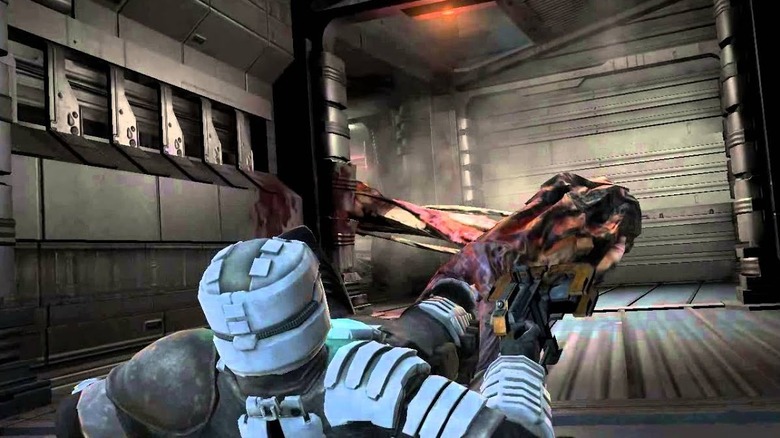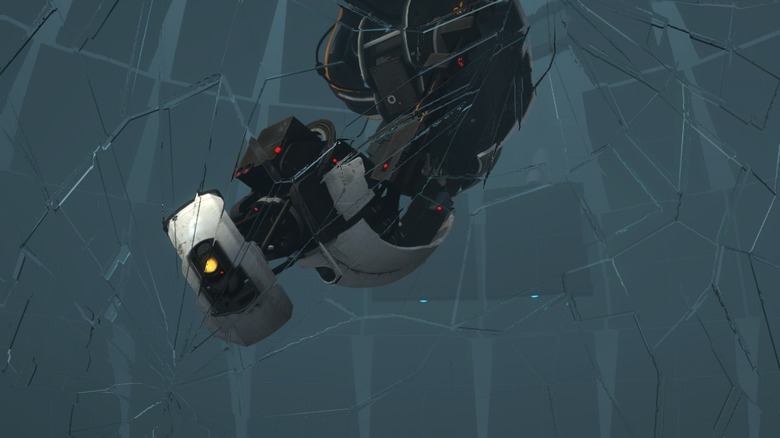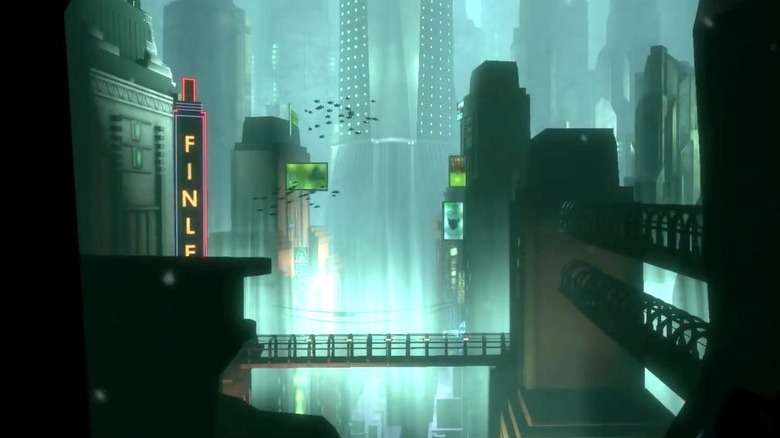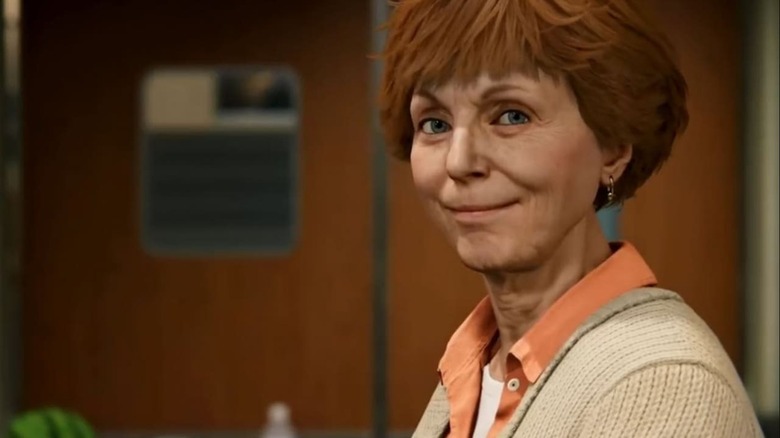Iconic Game Scenes That Were Never Supposed To Happen
Video games may be a lot of fun, full of eye-catching graphics and heart-pounding action sequences, but they can also make their players feel something. They transport you into a new world, a place where you can immerse yourself in a story and let it carry you away. Games are full of all sorts of moments that make a lasting impact.
Some games have terrifying moments that shake you to the core, like the first encounter with an invisible monster in "Amnesia: The Dark Descent". Others have moments that are downright cringeworthy, such as the infamous interspecies kiss in 2006's "Sonic the Hedgehog." Whether it's an immersive introduction like the cart scene in "Skyrim" or a shocking and emotional turn like the devastating intro to "The Last of Us," so many games are only as good as their most memorable moments.
That's why it's jarring to learn that some truly iconic moments and characters from certain video games were nearly left on the cutting room floor. Whether they were considered too difficult to animate, subject to massive studio notes, or were last-minute additions just before a game's release, here's a look at some iconic game scenes that were never supposed to happen.
Beware of major spoilers for the following games.
Psychonauts 2's boss battles
"Psychonauts 2", the sequel to the popular platform game "Psychonauts", was met with favorable reviews following its release in August 2021. Like its predecessor, the game features some fascinating and bizarre bosses against enemies like the Die-Brarian, Lady Luctopus, and the Gluttonous Goats. However, these captivating fights were almost left on the cutting room floor.
Double Fine boss Tim Schafer revealed in an interview with G4 that, had the studio not been bought by Microsoft, the game would have been very different from the version that eventually released. Concerned about financial resources and scheduling troubles, Double Fine initially made the decision to remove the boss battles from the game, mainly because they'd be the easiest to trim.
However, due to the symbolic meanings of the bosses and the battles themselves in the world of "Psychonauts," Schafer did not want to cut the battles. So, when Microsoft asked what he would do with the game if resources were not a concern, he opted to put the boss fights back in.
The ending of The Last of Us
The 2013 action-adventure survival horror game "The Last of Us" was met with universal acclaim upon release. Players were captivated by Naughty Dog's story of smuggler Joel escorting teenage girl Ellie across a post-apocalyptic United States landscape filled with zombie-like monsters. Eurogamer editor-in-chief Oli Welsh called it "a beacon of hope" for the survival horror genre, and specifically praised the game's "brave" ending. The ending is not a happy one, leaving the main characters in a sad and uncertain place.
Oli Welsh, and likely many of the game's other fans, would have been sorely disappointed if "The Last of Us" had stuck with the original plan for the game's ending. The game's director, Neil Druckmann, revealed in an interview with Game Informer (via Eurogamer) that the game's original ending was much more hopeful, concluding with Ellie and Joel ready to start a new life in San Francisco. However, as the game's development progressed, Druckmann realized that this type of ending did not feel honest anymore, and would be too easy on Joel.
Though the new ending was a point of contention among Naughty Dog staff (as discussed in a Reddit AMA with Druckmann), it is the conclusion the team went with, and the emotional resonance of that darker ending speaks for itself.
God of War 3's infamous mini-game
The first two "God of War" games featured steamy sequences that played out between lead character Kratos and some topless women. They get down and dirty via a quick-time minigame, which, if played correctly, results in the women complimenting Kratos on his carnal prowess and gifting the Ghost of Sparta with Red Orbs.
In a UGO post (via Digital Spy), game director Stig Asmussen explained the original version of the scene was intended to help establish the character as "a man's man," someone that the ladies can, well, appreciate.
By the time the dev team got to "God of War 3," Asmussen wasn't sure if a similar scene should be included in the next title. Was it necessary to establish this character trait for Kratos a third time? Would it feel unnecessary, or end up upsetting people? Asmussen felt it was a case of "damned if you do" and "damned if you don't." Ultimately, the team settled on a solution: The scene would still occur, but it would also contain important information about the story and serve to move the plot forward.
Clementine's entire story in The Walking Dead
Who could forget the moment in Telltale Games' "The Walking Dead" when protagonist Lee Everett first encounters Clementine, the vulnerable child he will soon grow to care for like his own daughter? Clementine is a child who needs help, but she is also smart, perceptive, and kind, and living through horrors no child should ever have to witness. It's not hard to imagine the player growing attached to her, and caring deeply about what might befall her. However, only a week before the game's voice acting was scheduled to be recorded, there was talk of removing Clementine from the game entirely.
During a Game Developers Conference panel in 2013 (per Eurogamer), writer Jake Rodkin said the developers were concerned that the player would be frustrated by Clementine if she was not likable enough. She was almost cut for fear that players would feel trapped and burdened by her, rather than care about her wellbeing. Thankfully, Clementine was not removed from the game, and the role won voice actor Melissa Hutchison a Spike Video Game Award for "Best Performance by a Human Female."
Lucina was almost cut from Fire Emblem Warriors
"Fire Emblem Warriors" is a musou hack-and-slash action roleplaying game featuring characters from several of the "Fire Emblem" games, including Lucina and her father Chrom. The game includes a heartfelt scene in which Lucina reveals her identity to Chrom, introducing herself to him, much to his shock, as his daughter. This tender and memorable father-daughter reunion almost didn't take place, however, as Lucina was nearly left out of the game.
In an interview with Nintendo Dream (translation via Nintendo Everything), producer Yosuke Hayashi and director Hiroya Usuda explained that they initially planned to exclude Lucina from the game out of a concern that adding her in would give the game too many sword-wielding characters, as well as an uncertainty about whether any characters of the franchise's "children generation" would be included. However, after deciding that her role in the events would make the story more interesting, the devs added Lucina to the final roster of characters.
God of War's return to the Chaos Blades
"God of War" is a game full of powerful, impactful moments, but one of the most iconic is the scene where Kratos returns to his home to fetch the Blades of Chaos, bringing his journey full circle. In an interview with GameSpot, director Cory Barlog shared that this scene almost didn't happen, as the Blades of Chaos posed several potential problems that could hamper the development process.
First, there was concern that there would not be enough time to tweak the weapon for an optimal player experience, as it was added during the game's last year of development. In comparison, the Leviathan Axe took nearly four years of development time to perfect. Another potential issue stemmed from the game's new camera angle, which was now framed over the protagonist's shoulder and might make it difficult to get the Blades to look and feel like previous games.
However, Barlog considered the Blades of Chaos to be a necessary story inclusion, and so their triumphant return made it into the final game.
Dead Space's Drag Tentacle
The sci-fi survival horror title "Dead Space" features a menagerie of terrifying creatures, all ready to terrorize poor protagonist Isaac Clarke and rip him to shreds if given the chance. The game's monsters are the Necromorphs, corpses mutated into heart-pounding, stomach-churning new forms by an alien infection. Though they take on a wide variety of shapes, one of the deadliest is the Drag Tentacles, which reach through holes to, you guessed it, drag Isaac to his death. A particularly memorable and harrowing encounter with a Drag Tentacle occurs in the game's third chapter — and it's a moment that nearly didn't happen.
Glen Schofield, the creator and director of "Dead Space," delved into the process behind the game's development with Ars Technica and revealed how difficult it was to get the sequence right. The developers struggled with the animation, resorting to animating each part of the scene layer by layer. The team almost had to sacrifice the interactive element of the scene, which involves shooting at the tentacle to try to free Isaac, in order to make it work. However, it finally came together after quite a bit of trial and error, and the scariest Drag Tentacle sequence made it into the game after all.
Portal without GLaDOS
Even people who've never played a "Portal" game in their lives have probably heard a reference to the famous line, "The cake is a lie." This line refers to the reveal that the game's protagonist is being led through the action, and completing deadly tests, in service of a reward that she will never receive. The cake was promised to her by GLaDOS (Genetic Lifeform and Disk Operating System), the deadpan superintelligent computer antagonist of the game.
But what if there was never a promise of cake? What if that memed-to-death famous phrase never had a place in the game, because GlaDOS never existed? There would certainly be a lot fewer novelty t-shirts, that's for sure. Cake (or lack thereof) aside, GLaDOS is one of the most vital components of Portal, and a truly iconic video game villain. So, it's shocking to learn that "Portal" almost didn't include the robot-voiced sardonic narrator in the first place.
According to a TechRadar interview with game designer Robin Walker, the original version of the game had no antagonist at all, focusing entirely on the puzzles themselves. However, after playtester feedback indicated that the game felt incomplete, Walker realized that the puzzles alone were not enough to hold attention — without a force to drive them.
In an interview with Game Developer, writer Erik Wolpaw described how he came up with the idea for GLaDOS after using text-to-speech software to record temporary dialogue for "Psychonauts". Using this same technology to play around with temporary dialogue for "Portal," the team came up with the idea for GLaDOS' cold (but funny) speech patterns. Thankfully they did, so she could rise to the status of being a famous and beloved video game villain.
Bioshock's opening scene
2007's "Bioshock" opens with a series of visually stunning and surprising events. The player character begins on an airplane, having a cigarette and looking at a photograph. He remarks to himself that his parents told him he could be special. Then, the plane crashes. In the midst of the wreckage, confusion, and mad scramble for survival, the protagonist finds himself being taken through a beautiful and terrifying underwater city called Rapture. He is plunged into a strange Art Deco world of mystery and danger, and cannot turn back no matter how badly he might want to.
Business Insider called it the best video game opening scenes of all time, and yet it almost didn't happen in the way players know and love.
"Bioshock" series creator Ken Levine opened up about the hurdles of making this intro to Rolling Stone. With the game nearly finished, a focus test came back with negative responses. Following this feedback, Levine realized that the players would need to feel more connected to the game's protagonist to care about the events that followed. The developers added the plane crash scene, incorporating things like the cigarette as a way to indicate the time period, and giving the protagonist a sympathetic line of dialogue to humanize him.
Aunt May almost Cut from Playstation's Spider-Man
One of the most heartbreaking scenes in "Marvel's Spider-Man" features Peter Parker at the side of Aunt May's hospital bed, wrestling with the reality that she is probably going to die. As Spider-Man voice actor Yuri Lowenthal explained to The GameZone Podcast, this scene almost not make it into the game, with Marvel Comics originally pushing back on the idea. As if that's not bad enough, but Aunt May was almost left out of the game entirely.
"Spider-Man" without Aunt May? Say it isn't so! She's Peter's guardian, the shoulder he can cry on, and the only person who can understand what it felt like to lose Uncle Ben. But yes, her presence as a physical character in the game nearly wasn't included.
Comics writer Dan Slott explained in an interview with GamesRadar that the original plan was to have Aunt May only show up as a voice speaking to Peter on the phone or heard over the radio. Insomniac allegedly told Slott, who worked on the game's narrative, that animating older characters with wrinkles was too difficult, and would require too many resources. Luckily, Slott convinced Insomniac that Aunt May was integral to the story, allowing players to see this familiar face — and have their hearts torn out of their chests by her storyline, too.

